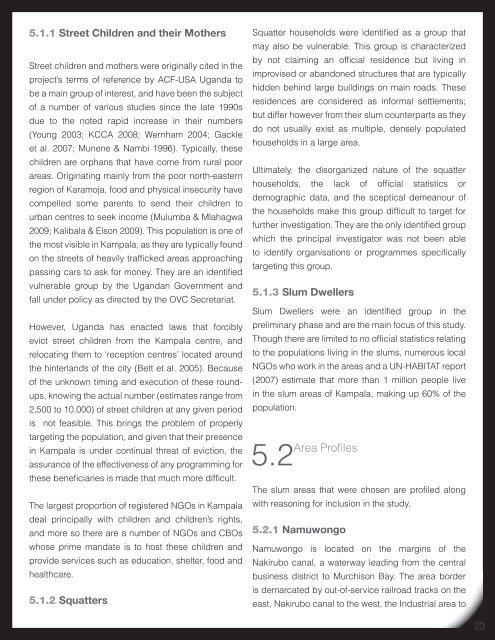Exploring livelihoods of the urban poor in Kampala, Uganda
Exploring livelihoods of the urban poor in Kampala, Uganda
Exploring livelihoods of the urban poor in Kampala, Uganda
You also want an ePaper? Increase the reach of your titles
YUMPU automatically turns print PDFs into web optimized ePapers that Google loves.
5.1.1 Street Children and <strong>the</strong>ir Mo<strong>the</strong>rs<br />
Street children and mo<strong>the</strong>rs were orig<strong>in</strong>ally cited <strong>in</strong> <strong>the</strong><br />
project’s terms <strong>of</strong> reference by ACF-USA <strong>Uganda</strong> to<br />
be a ma<strong>in</strong> group <strong>of</strong> <strong>in</strong>terest, and have been <strong>the</strong> subject<br />
<strong>of</strong> a number <strong>of</strong> various studies s<strong>in</strong>ce <strong>the</strong> late 1990s<br />
due to <strong>the</strong> noted rapid <strong>in</strong>crease <strong>in</strong> <strong>the</strong>ir numbers<br />
(Young 2003; KCCA 2008; Wernham 2004; Gackle<br />
et al. 2007; Munene & Nambi 1996). Typically, <strong>the</strong>se<br />
children are orphans that have come from rural <strong>poor</strong><br />
areas. Orig<strong>in</strong>at<strong>in</strong>g ma<strong>in</strong>ly from <strong>the</strong> <strong>poor</strong> north-eastern<br />
region <strong>of</strong> Karamoja, food and physical <strong>in</strong>security have<br />
compelled some parents to send <strong>the</strong>ir children to<br />
<strong>urban</strong> centres to seek <strong>in</strong>come (Mulumba & Mlahagwa<br />
2009; Kalibala & Elson 2009). This population is one <strong>of</strong><br />
<strong>the</strong> most visible <strong>in</strong> <strong>Kampala</strong>, as <strong>the</strong>y are typically found<br />
on <strong>the</strong> streets <strong>of</strong> heavily traf cked areas approach<strong>in</strong>g<br />
pass<strong>in</strong>g cars to ask for money. They are an identi ed<br />
vulnerable group by <strong>the</strong> <strong>Uganda</strong>n Government and<br />
fall under policy as directed by <strong>the</strong> OVC Secretariat.<br />
However, <strong>Uganda</strong> has enacted laws that forcibly<br />
evict street children from <strong>the</strong> <strong>Kampala</strong> centre, and<br />
relocat<strong>in</strong>g <strong>the</strong>m to ‘reception centres’ located around<br />
<strong>the</strong> h<strong>in</strong>terlands <strong>of</strong> <strong>the</strong> city (Bett et al. 2005). Because<br />
<strong>of</strong> <strong>the</strong> unknown tim<strong>in</strong>g and execution <strong>of</strong> <strong>the</strong>se roundups,<br />
know<strong>in</strong>g <strong>the</strong> actual number (estimates range from<br />
2,500 to 10,000) <strong>of</strong> street children at any given period<br />
is not feasible. This br<strong>in</strong>gs <strong>the</strong> problem <strong>of</strong> properly<br />
target<strong>in</strong>g <strong>the</strong> population, and given that <strong>the</strong>ir presence<br />
<strong>in</strong> <strong>Kampala</strong> is under cont<strong>in</strong>ual threat <strong>of</strong> eviction, <strong>the</strong><br />
assurance <strong>of</strong> <strong>the</strong> effectiveness <strong>of</strong> any programm<strong>in</strong>g for<br />
<strong>the</strong>se bene ciaries is made that much more dif cult.<br />
The largest proportion <strong>of</strong> registered NGOs <strong>in</strong> <strong>Kampala</strong><br />
deal pr<strong>in</strong>cipally with children and children’s rights,<br />
and more so <strong>the</strong>re are a number <strong>of</strong> NGOs and CBOs<br />
whose prime mandate is to host <strong>the</strong>se children and<br />
provide services such as education, shelter, food and<br />
healthcare.<br />
5.1.2 Squatters<br />
Squatter households were identi ed as a group that<br />
may also be vulnerable. This group is characterized<br />
by not claim<strong>in</strong>g an <strong>of</strong> cial residence but liv<strong>in</strong>g <strong>in</strong><br />
improvised or abandoned structures that are typically<br />
hidden beh<strong>in</strong>d large build<strong>in</strong>gs on ma<strong>in</strong> roads. These<br />
residences are considered as <strong>in</strong>formal settlements;<br />
but differ however from <strong>the</strong>ir slum counterparts as <strong>the</strong>y<br />
do not usually exist as multiple, densely populated<br />
households <strong>in</strong> a large area.<br />
Ultimately, <strong>the</strong> disorganized nature <strong>of</strong> <strong>the</strong> squatter<br />
households, <strong>the</strong> lack <strong>of</strong> <strong>of</strong> cial statistics or<br />
demographic data, and <strong>the</strong> sceptical demeanour <strong>of</strong><br />
<strong>the</strong> households make this group dif cult to target for<br />
fur<strong>the</strong>r <strong>in</strong>vestigation. They are <strong>the</strong> only identi ed group<br />
which <strong>the</strong> pr<strong>in</strong>cipal <strong>in</strong>vestigator was not been able<br />
to identify organisations or programmes speci cally<br />
target<strong>in</strong>g this group.<br />
5.1.3 Slum Dwellers<br />
Slum Dwellers were an identi ed group <strong>in</strong> <strong>the</strong><br />
prelim<strong>in</strong>ary phase and are <strong>the</strong> ma<strong>in</strong> focus <strong>of</strong> this study.<br />
Though <strong>the</strong>re are limited to no <strong>of</strong> cial statistics relat<strong>in</strong>g<br />
to <strong>the</strong> populations liv<strong>in</strong>g <strong>in</strong> <strong>the</strong> slums, numerous local<br />
NGOs who work <strong>in</strong> <strong>the</strong> areas and a UN-HABITAT report<br />
(2007) estimate that more than 1 million people live<br />
<strong>in</strong> <strong>the</strong> slum areas <strong>of</strong> <strong>Kampala</strong>, mak<strong>in</strong>g up 60% <strong>of</strong> <strong>the</strong><br />
population.<br />
5.2<br />
Area Pro les<br />
The slum areas that were chosen are pro led along<br />
with reason<strong>in</strong>g for <strong>in</strong>clusion <strong>in</strong> <strong>the</strong> study.<br />
5.2.1 Namuwongo<br />
Namuwongo is located on <strong>the</strong> marg<strong>in</strong>s <strong>of</strong> <strong>the</strong><br />
Nakirubo canal, a waterway lead<strong>in</strong>g from <strong>the</strong> central<br />
bus<strong>in</strong>ess district to Murchison Bay. The area border<br />
is demarcated by out-<strong>of</strong>-service railroad tracks on <strong>the</strong><br />
east, Nakirubo canal to <strong>the</strong> west, <strong>the</strong> Industrial area to<br />
23

















